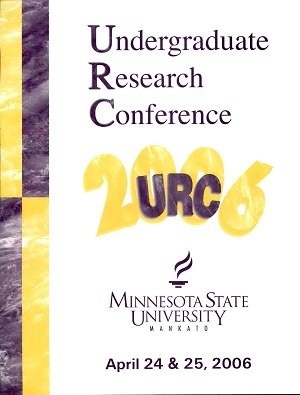Impact of Antibiotic Therapy on Regeneration Following Caudal Amputation in the Earthworm
Location
CSU North Ballroom
Start Date
24-4-2006 1:30 PM
End Date
24-4-2006 3:30 PM
Student's Major
Biological Sciences
Student's College
Science, Engineering and Technology
Mentor's Name
Dorothy Wrigley
Mentor's Department
Biological Sciences
Mentor's College
Science, Engineering and Technology
Description
Antibiotic treatment is commonly used to prevent infection during surgery. The degree and duration of antibiotic treatment, however, are open to further study. This study addressed the impact of antibiotic therapy on tissue repair in a caudal amputation earthworm model. Four groups of six worms each underwent amputation and each group was treated differently. Group 1 was the control group which received no antibiotic treatment before or after amputation. Group 2 received antibiotic treatment for 3 hours prior to amputation, and no treatment thereafter. Group 3 received no treatment prior to amputation, but was treated with antibiotic for a 24 hour time period each subsequent week of the study. Group 4 received antibiotic treatment for 2 hours prior to amputation, and received continuous antibiotic treatment over the entire course of the study. The re-growth of the tail was assessed over the next seven weeks by measuring the regenerated tail length and the weight gain by the worms. Data will be presented that shows that pretreatement with antibiotics aided regrowth of tail. Tail growth appeared to go through 3 stages based on rate of growth. Weight changes did not parallel tail regrowth. Further study would examine the impact of antibiotic therapy at the different stages of growth.
Impact of Antibiotic Therapy on Regeneration Following Caudal Amputation in the Earthworm
CSU North Ballroom
Antibiotic treatment is commonly used to prevent infection during surgery. The degree and duration of antibiotic treatment, however, are open to further study. This study addressed the impact of antibiotic therapy on tissue repair in a caudal amputation earthworm model. Four groups of six worms each underwent amputation and each group was treated differently. Group 1 was the control group which received no antibiotic treatment before or after amputation. Group 2 received antibiotic treatment for 3 hours prior to amputation, and no treatment thereafter. Group 3 received no treatment prior to amputation, but was treated with antibiotic for a 24 hour time period each subsequent week of the study. Group 4 received antibiotic treatment for 2 hours prior to amputation, and received continuous antibiotic treatment over the entire course of the study. The re-growth of the tail was assessed over the next seven weeks by measuring the regenerated tail length and the weight gain by the worms. Data will be presented that shows that pretreatement with antibiotics aided regrowth of tail. Tail growth appeared to go through 3 stages based on rate of growth. Weight changes did not parallel tail regrowth. Further study would examine the impact of antibiotic therapy at the different stages of growth.
Recommended Citation
Bulian, Brady. "Impact of Antibiotic Therapy on Regeneration Following Caudal Amputation in the Earthworm." Undergraduate Research Symposium, Mankato, MN, April 24, 2006.
https://cornerstone.lib.mnsu.edu/urs/2006/poster-session-B/3



